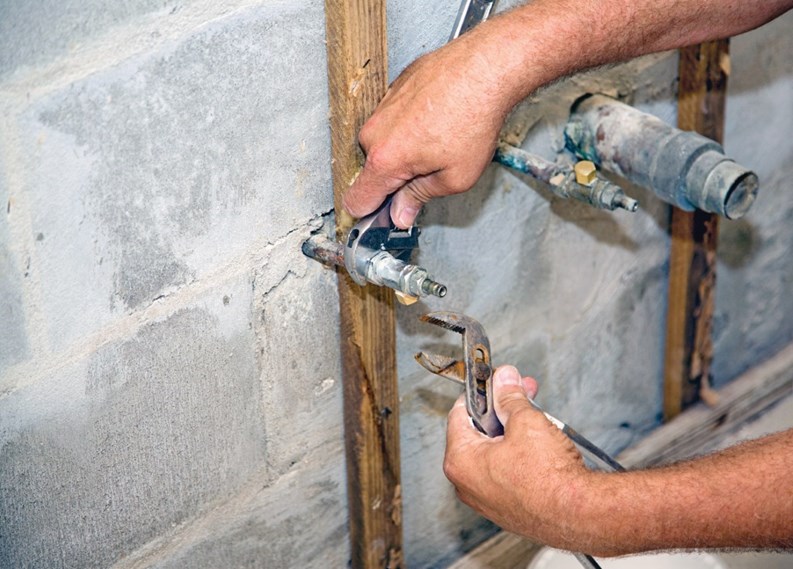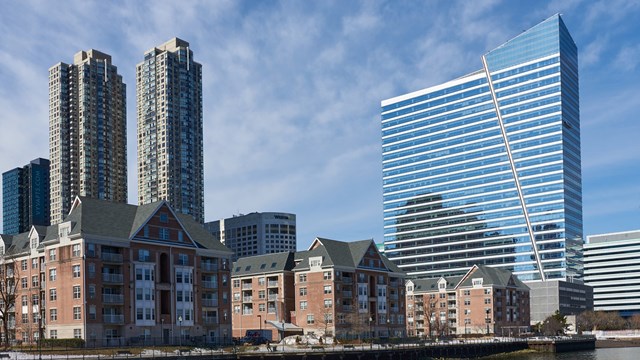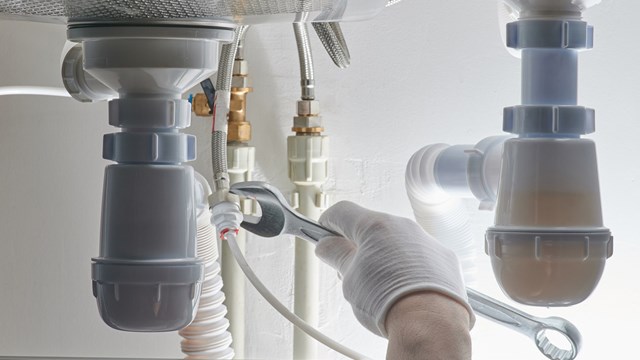Few things illustrate the fragility of modern civilization more clearly than plumbing problems. A broken pipe, a backed-up toilet, a flooded bathroom—any one of these can quickly go from annoyance to emergency, and the longer a plumbing problem lingers, the more unsavory the situation gets. Without efficient, functional plumbing, a densely populated urban or suburban area can go from metropolitan to Medieval in very short order.
But how exactly does your building’s plumbing system work? That answer has been several hundred years in the making—and the more your manager, board, and residents know about how it all ties together to bring the good in and flush the bad out, the better prepared your building association will be if your own plumbing system develops problems.
Plumbing the Depths
According to Plumbing and Mechanical Magazine, the ancient Minoans hold the honor of being the first civilization with a flush toilet, located within the Palace of Knossos.
With increased engineering skill and the introduction of lead pipes, the Romans took plumbing up a few notches with fresh water (thanks to their awe-inspiring system of aqueducts), heated floors, grand bath houses, dams, drains and sewer systems.
Roman innovation didn’t last, however—from the Dark Ages to as late as the 1600s, folks were back to using chamber pots. Even more charming, they generally emptied those pots in the street—a habit that did little for public health and sanitation.
Early Americans didn’t fare much better—at least not at first. It wasn’t until the 1700s when a wooden pipe system was put in place in New York City, and chamber pots began to be phased out.
The early 1800s finally saw construction of a public waterworks system, and by the 1900s, fewer and fewer Americans had to traipse across freezing yards to outhouses in the dead of night. Indoor became viewed less as a luxury and more as a basic necessity—so much so that from 1929 to 1954, purchases of indoor plumbing equipment rose more than 350 percent.
Here and Now
Today, most multifamily residential buildings use one of two systems to provide water and sanitation service to their inhabitants: either a gravity-fed or pressure tank system. Which type of system a building uses is based partly on the building’s height and the amount of water pressure available.
With gravity-fed tanks, city water comes in to the building under regular municipal water pressure, then goes through booster tanks which propel the water into rooftop storage tanks. From there, gravity distributes the water down to the units below.
By contrast, with a pressure tank system water comes into the building and proceeds into pre-pressurized tanks located in the basement, which then propel the water upward into the apartment units. In buildings with pumps, pressure starts high in the basement in order to get the water all the way to the top floors.
Some older buildings use combined gravity/pressure systems, while others only use one or the other. Still other buildings may use municipal water pressure to supply their first few floors, then one of the mechanical systems for the higher floors. In either case, pressure-reducing valves are used to keep all apartments below 85 pounds per square-inch (PSI).
Newer multifamily buildings rely more on pressure tank systems, which tend to be easier to maintain. “If one tank goes, they have separate valves that allow you to repair one tank at a time,” says Henry Billharz, co-owner of Billharz Plumbing Inc. in Woodside, Queens. He says it’s also easier to add a pressure system to a building that needs changes to its plumbing infrastructure. For example, if a building with a pressure system decides to install new appliances with different water flow needs, or decides to start filtering water, or adds a reduced pressure zone valve (to prevent backflow into the city water system), all a certified plumbing crew may have to do is add a new valve or two.
When it comes to repairs, though, “[The advantage of] the gravity system is its simplicity,” says Billharz. “As long as you can get the water to the roof, gravity will do the rest. In pressure tanks, bladders can break. Booster pumps can go out. Those pumps need to be greased and maintained regularly.”
Plumbing Problems
Of course, a building’s plumbing system requires a certain amount of maintenance in order to remain efficient, functional, and hygienic—but with all the talk of pipes and piping systems, the problems plumbers face most often have to do with fixtures, like tubs, toilets, and appliances.
“We see a lot of clogged toilets,” says Yavi Golani, owner of YG Services in Watertown, Massachusetts. “Or there’s no heat in the hot water heater. Broken toilets, garbage disposals.”
Dave Fox, the owner of ASA Plumbing & Heating Services in Enfield, Connecticut, sees similar small-scale problems. “Shower valves, drains for the tub and shower—all bath stuff, really,” he says.
In multifamily buildings, these sorts of leaks can have a trickle-down effect—literally. A leaking tub drain on the third floor can ruin the ceiling of the unit below. “We’re forever opening ceilings,” says one plumbing professional.
Then there are times when the problem is not confined to one unit.
“I had the sewer main break in a 30-unit apartment,” Fox recalls. “The sewer main under the building snapped, sewage was coming up—and people were still living there.”
It took two days to clean up the mess and fix the leak.
As with any kind of ongoing maintenance need, plumbing pros recommend repairing things as they happen—not waiting for a minor issue to become a soggy catastrophe before calling someone. Fixing leaks, investigating a perpetually running toilet, and properly maintaining hot water heaters can save money and hassle in the long run—and the consequences of a neglected plumbing system can be devastating. The cost of retaining a plumber’s services pales in comparison to the price of repairing buckling floors, rotted joists or decaying walls.
Finding the Source
According to plumbing pros, it’s almost inevitable that leaks will spring up and valves will get out of whack over time. The problem is getting deep inside the walls to the risers so that you have access to the valves and leak-sites. Usually, the treatment involves cutting into walls and ceilings—though much like medical surgery, the process has come a long way in recent years.
According to Joseph J. Leach, president of Leach Bros, Inc., a plumbing company in Pennsauken, New Jersey, if there is no apparent water damage, “to test for leaks, you first have to make sure that a leak even exists.” Plumbers can check for leaks by using an ‘air test’ that pumps air into the pipes and checks to make sure the air pressure holds for a certain amount of time (about twenty minutes.) If the pressure drops, you can conclude there is a leak. If a leak is detected, but the location of the leak cannot be found, often more air pressure is added to the system, and plumbers can listen for the sound of escaping air to track down the problematic area. should make noise that makes allows for detection.
According to Howard Bromberg, a licensed master plumber with Smith Plumbing, Inc. in Lumberton, New Jersey, finding a leak in a pipe behind drywall can be done almost laparascopically. “We have two mini cameras that we use,” he says. “We can drill a small hole in the hall, stick the camera through, and look for the leaks that way.”
Today’s professional plumbing crews are able to peer into walls with the latest tools and leak-finding technology, causing residents the least amount of inconvenience possible. After cutting small holes in the wall, “We go in with small glasses and mirrors to locate the source of the leak,” Billharz says.
And of course, sometimes plumbers find very odd things during the course of their investigations.
“Somebody tried to flush a small baseball,” says Golani. “And condoms are everywhere.” “I found a squirrel,” says Fox. (sadly, the animal did not survive the adventure). Another plumber says he found a Batman figurine lodged in a toilet drain during one routine inspection, and others tell stories of clothing, bathroom sponges, and even apple cores flushed where they most certainly shouldn’t be.
Bringing in the Professionals
For many of the plumbing woes discussed above, a good superintendent can do repairs without much of a problem. “If you have a good super, he can see corrosion building up on pipes, for example, and make sure that valves are properly labeled” Billharz says.
Sometimes however, even the best super may not be equipped or qualified to tackle a major plumbing problem—such as when leaks are causing damage behind walls. Bromberg advises that “Anything that involves drain cleaning, clearing internal drain clogs, anything to do with the gas system—I don’t recommend a homeowner work on those. There could be leaks inside the walls.”
Also, Leach mentions that the state of New Jersey has strict standards, especially with the handling of potable water. A super or handyman cannot do repairs on this, and since most buildings do not have a plumber as part of their staff, they really need to call one in when there is specific work that needs to be done.
Experts also advise hiring a professional plumber if there’s a large stoppage in the building that can’t be handled with small equipment, as well as for things like replacing toilets and pumps, adding fixtures or reconfiguring a bathroom. Whenever the larger plumbing apparatus is affected, it’s really not the time to hit Home Depot and “do-it-yourself.”
Billharz says he has seen plenty of instances where unit owners have made serious plumbing gaffes—installing toilets without outlets, for example, or tiling entire bathrooms and then deciding to move pipes. All of these fumbles are costly, but can be avoided easily by knowing when to set aside the do-it-yourself kit and call in the pros.
In the end, the key to good plumbing is maintenance. Keeping an eye out for problems before they start can save time, money and stress later on, something all of us can appreciate.
Hannah Fons is associate editor of The Cooperator. Additional reporting was conducted by Brendan Flaherty and Greg Olear.







Leave a Comment